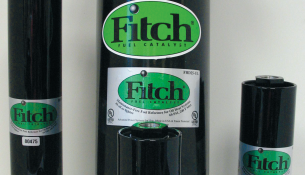All
Device Improves Fuel Economy by Changing Fuel’s Structure

A Connecticut company is marketing a fuel modification device that can help heating oil customers save 10 percent or more on fuel bills by deriving more heat from the fuel.
The Fitch Fuel Catalyst (FFC), created and marketed by Advanced Power Systems International, of Torrington, Conn., improves fuel performance by changing the fuel’s molecular structure to generate more heat.
Chris Wright, APSI’s Senior Vice President, told Oil & Energy the Catalyst uses a patented metal alloy to reformulate the fuel as it travels from the oil tank to the burner. The Catalyst is a cylindrical canister that resembles an oil filter and is installed between the oil filter and the burner.
As fuel passes through the Catalyst, it comes in contact with the specialized metal alloys that temporarily reformulate the fuel. This reformulation causes the fuel to burn hotter, which allows a technician to reduce the nozzle to a smaller size while maintaining the same BTU output. The change in nozzle demonstrated a reduction in fuel consumption of 10 percent to 20 percent, according to Wright.
Having encountered the expected “snake oil” skepticism about the product, APSI has collaborated with a research team at the University of Connecticut to test and validate the results. UConn’s Suib Research Group and CT Next, a Connecticut governmental agency, recently issued a report stating in part, “In the field test of both commercial and residential boilers the research team found fuel consumption was reduced by 9.1 percent to 20 percent.”
“Members of the research team spoke with engineers who maintain large numbers of boilers for property management companies, and reviewed their data over multiple years tracking the performance of the boilers when outfitted with Fitch Fuel Catalyst units, the UConn report adds. “They found an average reduction in fuel consumption across all commercial installations of 14 percent.
“The research team noted that perhaps the biggest indirect indicator of fuel combustion savings from installation of the Fitch Fuel Catalyst is that all of the customers interviewed who are in a position to order successive units for other installations continue to purchase and use the Fitch Fuel Catalyst units.”
Wright said the Catalyst, which is also marketed under the brand name GOSaver, can be installed on any oil-heated system by a licensed technician with basic plumbing skills. The metals in the device do not leech into the fuel, and there is no fuel additive component. The Catalyst works on biofuel blends as well as pure petroleum products.
The UConn report describes the process. “The inside of a Fitch Fuel Catalyst consists of a patented mixture of metallic alloys that, when exposed to fuels, causes a temporary catalytic conversion that can last for several days, depending on a number of environmental variables,” the report states. “Specifically, the Fitch Fuel Catalyst can extract hydrogen atoms from different fuel components, thereby changing the composition of the fuel. Oxygen is present when the catalyst is exposed to the fuel and oxygenated compounds that can burn more efficiently are produced.”
In addition to reducing consumption, the Catalyst also results in cleaner combustion with less residue inside the combustion chamber. “Verizon installed the Catalyst in 50 buildings in New York City, and they have not cleaned a boiler in four years,” Wright said.
Underwriters Laboratory (UL) created a new category, Catalyst Reformer, to accommodate the Fitch Fuel Catalyst technology. All Fitch Fuel Catalyst heating units reflect the UL listing on the label and Wright states, “We are pleased to see our catalyst technology is now widely accepted in various different markets.”
For more information, visit www.fitchfuelcatalyst.com or inquire at info@fitchfuelcatalyst.com.
Related Posts
 Why Quality Matters in Your Biofuel Blends
Why Quality Matters in Your Biofuel Blends
Posted on June 25, 2025
 Incorporating Higher Blends of Biofuels
Incorporating Higher Blends of Biofuels
Posted on May 14, 2025
 NORA Programs at Eastern Energy Expo
NORA Programs at Eastern Energy Expo
Posted on May 13, 2025
 March Short-Term Energy Outlook
March Short-Term Energy Outlook
Posted on April 28, 2025
Enter your email to receive important news and article updates.
